I am purchasing a round diamond table 59%, depth % 60.9%, angle 34.5 and angle 40.8. It looked very nice, and when I put it in the HCA calculator it was 1.7 so I thought I was good to go, the vender did tell me the table was just out of H&A range but he felt it was just as beautiful because the angles were great, but now that i've hoped online to this forum I see perhaps 59% is not a good thing, its 2.5 carets so it will be noticeable if it doesn't look "right". Thoughts?
You are using an out of date browser. It may not display this or other websites correctly.
You should upgrade or use an alternative browser.
You should upgrade or use an alternative browser.
Cut 59%
- Thread starter AEM27
- Start date
- Joined
- Nov 7, 2015
- Messages
- 2,979
- Joined
- Jan 2, 2017
- Messages
- 1,851
- Joined
- Jul 31, 2014
- Messages
- 20,042
The figures seem unrealistic.
Why?
- Joined
- Dec 8, 2016
- Messages
- 457
- Joined
- Aug 15, 2000
- Messages
- 19,012
Why, if the rounded numbers are accurate the girdle will be 3.7% Medium. I assume it has a GIA report?The figures seem unrealistic.
Also no reason it would not have H&A's if the symmetry is good enough, but it is hard to find H&A above 2ct.
I would not go above 60% table for a larger stone, but 59% is good.
- Joined
- Apr 23, 2018
- Messages
- 5,870
While we may prefer a smaller table it does not mean this is a bad stone. I'm mobile but below is a chicken scratch markup of the AGS proportions charts to show you how the stone lands with a 59 table and 34.5/40.8 combo.
Looking at your cert I saw this is an SI2 stone. Most SI2's aren't eye clean, especially in larger stones. But some DO exist. You just need to make sure.
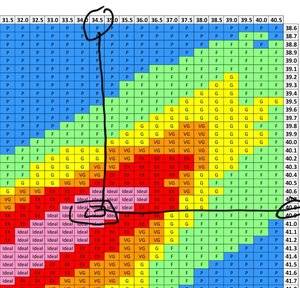
Looking at your cert I saw this is an SI2 stone. Most SI2's aren't eye clean, especially in larger stones. But some DO exist. You just need to make sure.

- Joined
- Feb 29, 2012
- Messages
- 12,369
- Joined
- Apr 23, 2018
- Messages
- 5,870
Have you ever looked at the AGS proportions charts? Most table sizes have an "ideal" cut range. However on a 62 table, there is only about 7 combinations that work. On 63+ tables, there are none.
https://agslab.com/docs/pbcg/AGSLProportionCharts.pdf
That said, the table size can alter the character of the stone. Some of the reasons people posted information on 60/60 stones is because they tend to produce a more bright, white type diamond. However, they can still exhibit an ideal cut and be quite firey as well. As you move towards a true 60/60 stone you will notice how the charts shift the angles a little from a stone with a 54 table. With a smaller table, the 34.5/40.8 angle combo puts you very deep into ideal territory. On a 60 table, this still remains in ideal but you can see how it is creeping to the outer edges and something like a 33/41.1 combo would put you deeper into ideal territory.
Here is some more information on table sizes you may find useful:
https://www.whiteflash.com/about-diamonds/diamond-education/60-60-diamonds-1503.htm
https://www.prosumerdiamonds.com/pavilion-depth-table/
The proportions you read about on here, and was likely trying to meet was something similar to the following:
This is a particularly nice read about TIC diamonds. Notice in the diagram below the original design is based on a 0% girdle. That is impossible. When adding for a medium girdle (3% thickness) this pushes your overall depth closer to the 62.3% range.
https://niceice.com/tolkowsky-ideal-cut-diamonds/
https://beyond4cs.com/grading/girdle-thickness/
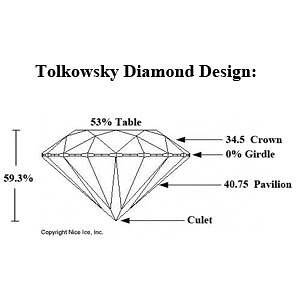
Lastly I might add that using this criteria we are also able to produce a stone with hearts & arrow (H&A) symmetry. This particular page goes into much more detail, but since you are worried about the table size, I wanted to share that bit of information here.
https://www.heartsandarrows.com/hearts-arrows-diamond-ideal-cut-dna.aspx
See how on a larger table the shoulders of the hearts come to a point? On a smaller 55 table, you will see they are more squared off and what is considered better symmetry.
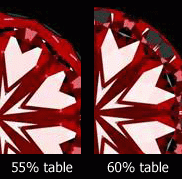
Additionally we can see how table size can affect the arrows portion as well.
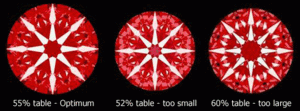
In closing I would like to clarify that I am trying to provide you more technical data to allow you to understand what you are purchasing, and not sway your decision. It sounds like the stone you are trying to purchase makes you happy. Some of the information being discussed here may not have any meaningful impact on your life, and I certainly do NOT think the stone in question will look "cheap" by any means.
But if you are uncertain, please provide us a budget and we can try to find something more to your liking. Or at least confirm, you are getting a good deal.
https://agslab.com/docs/pbcg/AGSLProportionCharts.pdf
That said, the table size can alter the character of the stone. Some of the reasons people posted information on 60/60 stones is because they tend to produce a more bright, white type diamond. However, they can still exhibit an ideal cut and be quite firey as well. As you move towards a true 60/60 stone you will notice how the charts shift the angles a little from a stone with a 54 table. With a smaller table, the 34.5/40.8 angle combo puts you very deep into ideal territory. On a 60 table, this still remains in ideal but you can see how it is creeping to the outer edges and something like a 33/41.1 combo would put you deeper into ideal territory.
Here is some more information on table sizes you may find useful:
https://www.whiteflash.com/about-diamonds/diamond-education/60-60-diamonds-1503.htm
https://www.prosumerdiamonds.com/pavilion-depth-table/
The proportions you read about on here, and was likely trying to meet was something similar to the following:
- 54-57 table
- 60-62.4 depth
- 34-35 crown (maybe 35.5 if paired with 40.6 pavilion)
- 40.6-40.9 pavilion (maybe 41 if paired with 34 crown)
- 75-80 lower girdle facets
This is a particularly nice read about TIC diamonds. Notice in the diagram below the original design is based on a 0% girdle. That is impossible. When adding for a medium girdle (3% thickness) this pushes your overall depth closer to the 62.3% range.
https://niceice.com/tolkowsky-ideal-cut-diamonds/
https://beyond4cs.com/grading/girdle-thickness/

Lastly I might add that using this criteria we are also able to produce a stone with hearts & arrow (H&A) symmetry. This particular page goes into much more detail, but since you are worried about the table size, I wanted to share that bit of information here.
https://www.heartsandarrows.com/hearts-arrows-diamond-ideal-cut-dna.aspx
See how on a larger table the shoulders of the hearts come to a point? On a smaller 55 table, you will see they are more squared off and what is considered better symmetry.

Additionally we can see how table size can affect the arrows portion as well.

In closing I would like to clarify that I am trying to provide you more technical data to allow you to understand what you are purchasing, and not sway your decision. It sounds like the stone you are trying to purchase makes you happy. Some of the information being discussed here may not have any meaningful impact on your life, and I certainly do NOT think the stone in question will look "cheap" by any means.
But if you are uncertain, please provide us a budget and we can try to find something more to your liking. Or at least confirm, you are getting a good deal.
Last edited:
Thanks! . I’m getting this for around $20.5 with traditional platinum setting, was trying to stay under that. Originally i was looking at one that was I colored, H&A proportions and I took to long to go back and it got taken, so this one was suggested since I guess it's sort of hard to find something in this range, i am working with one of the vendors recommended here.
- Joined
- Jan 2, 2017
- Messages
- 1,851
Totally agree with what @sledge has mentioned above. The hearts images if you are able to get them will give an indication of how well cut the stone is but IRL, you will not notice that at all as hearts images are taken pavilion side up.
I used to have a preference against 60/60 stones in the past, but after seeing a few more in person and on online vids, if they are cut well, they will have as much personality as a “traditional” super ideal stone. Really comes down to what your eyes like more.
I used to have a preference against 60/60 stones in the past, but after seeing a few more in person and on online vids, if they are cut well, they will have as much personality as a “traditional” super ideal stone. Really comes down to what your eyes like more.
- Joined
- Aug 15, 2000
- Messages
- 19,012
For the record Jasper Paulsen and Bruce Harding reworked Tolkowsy math by adding a girdle. the thicker the girdle the larger the table should be.
This stone has a med to slightly thick girdle and as such the table size should not be under 56%. What is 3% really?
http://www.folds.net/diamond_girdle/ There is a tool you can use - but just scroll down to where the chart is. This gridle averages about 2 to 2.5% at the thin parts that Jasper used.
This stone has a med to slightly thick girdle and as such the table size should not be under 56%. What is 3% really?
http://www.folds.net/diamond_girdle/ There is a tool you can use - but just scroll down to where the chart is. This gridle averages about 2 to 2.5% at the thin parts that Jasper used.
For the record Jasper Paulsen and Bruce Harding reworked Tolkowsy math by adding a girdle. the thicker the girdle the larger the table should be.
This stone has a med to slightly thick girdle and as such the table size should not be under 56%. What is 3% really?
http://www.folds.net/diamond_girdle/ There is a tool you can use - but just scroll down to where the chart is. This gridle averages about 2 to 2.5% at the thin parts that Jasper used.
So with a typical 3/3.5 girdle what problems with performance would there be with a 54/55 table relative to 56, if any..
- Joined
- Apr 23, 2018
- Messages
- 5,870
So with a typical 3/3.5 girdle what problems with performance would there be with a 54/55 table relative to 56, if any..
Good question. I haven't had time to read through the article so maybe I'm being lazy as I'm sure the answer lies in the math.
My initial guess is it's a mathematical expression of value that our eyes may not detect.
- Joined
- Aug 4, 2008
- Messages
- 15,641
- Joined
- Aug 15, 2000
- Messages
- 19,012
2% is measured here at the valley. Today we measure at the peaks of the girdle which usually means adding about 1.8%.The mathematical numbers they suggest are very different to what we see in ideal diamonds now. Their average 2% girdle (which is not equivalent to the maximum GIA girdle %) indicates that shallower diamonds are much preferable (looking at figure 8 in note 24).
Also Mr T only calculated the main facets, which given how short the lower girdle pavilion facets were was more valid that it is today (Karl snow dome effect?).
- Joined
- Aug 4, 2008
- Messages
- 15,641
The short lowers and small table of the Tolkowsy model did not take into account the lower halve/facet angles that drive light return in modern cuts.2% is measured here at the valley. Today we measure at the peaks of the girdle which usually means adding about 1.8%.
Also Mr T only calculated the main facets, which given how short the lower girdle pavilion facets were was more valid that it is today (Karl snow dome effect?).
The lighting he used for comparisons also was different than today but interestingly lighting is moving back towards similar to what he used.
Softer and more diffused.
I think if he was doing it today he would come up with a range not a specific number set.
The TIC range in the HCA is a more complete model with modern rounds as long it is combined with appropriate lowers.
Last edited:
- Joined
- Apr 23, 2018
- Messages
- 5,870
Hey @gm89uk, as @Garry H (Cut Nut) pointed out, the difference in girdle thickness has to do with peaks and valleys, and also the difference between GIA certificate reporting and more precise reporting by AGS, Sarin, etc. Please refer to notes 4 & 5.
Note 4:
As shown in fig. 1, our calculations need the total thickness of the girdle. Similarly, GIA studies (and descriptions of diamonds) use the total thickness of the girdle (at the "mains"). But most of the real-world data about diamonds (e.g., from Sarin machines, AGS certificates, and on-line ads) reports the thin part of the girdle (at the "scallops").
To make this article as useful as possible in the real world, we will use the Sarin definition of the "girdle": "The average thickness of the thin parts of the girdle" (at the "scallops"). We will calculate the size of the "Girdle Wave". By adding the "girdle" and "Girdle Wave", we can find the total thickness of the girdle (at the "mains").
The girdle has three layers.
The "Girdle Wave" is the thickness of the top layer of the girdle plus the bottom layer of the girdle.
- At the top: The upper girdle facets (in the crown) extend below the tips of the kite facets.
- In the middle: The outer edge of the girdle is a circle. The girdle is thinnest (at the "scallops") between the bottoms of the upper girdle facets and the tops of the lower girdle facets. Sarin machines call this distance the "girdle thickness".
- At the bottom: The lower girdle facets (in the pavilion) extend above the tips of the pavilion main facets.
Note 5:
The middle layer can be any thickness at all. Sarin machines measure it and call it the "girdle thickness". Often the "girdle thickness" is between 0.7% and 2% of the diameter of medium-sized and large diamonds. (Small diamonds usually have a larger percentage girdle.)
@sledge sorry if my post wasn't clear, but in the brackets I was acknowledging their girdle measurement was not to be compared against GIA numbers for reasons you have elaborated on. That's why I stated average for their girdle measurements and maximum height of girdle for GIA
- Joined
- Aug 15, 2000
- Messages
- 19,012
I think it was Bruce Harding who showed Tolkowsky math worked for the range of inverse crown and pavilion angles KarlThe short lowers and small table of the Tolkowsy model did not take into account the lower halve/facet angles that drive light return in modern cuts.
The lighting he used for comparisons also was different than today but interestingly lighting is moving back towards similar to what he used.
Softer and more diffused.
I think if he was doing it today he would come up with a range not a specific number set.
The TIC range in the HCA is a more complete model with modern rounds as long it is combined with appropriate lowers.
- Joined
- Aug 15, 2000
- Messages
- 19,012
I don't know what GIA does now, but previously a 2ct diamond could have the same girdle thickness reding as a 1ct. They worked on a safe and non wasteful girdle thickness concept which is better I believe than the AGS lazy approach. A 100ct diamond should not have a Medium girdle thick enough to write on.@sledge sorry if my post wasn't clear, but in the brackets I was acknowledging their girdle measurement was not to be compared against GIA numbers for reasons you have elaborated on. That's why I stated average for their girdle measurements and maximum height of girdle for GIA
Share:





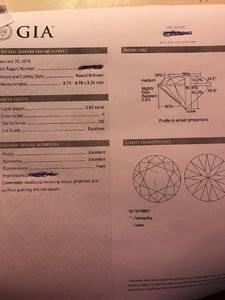


300x240.png)